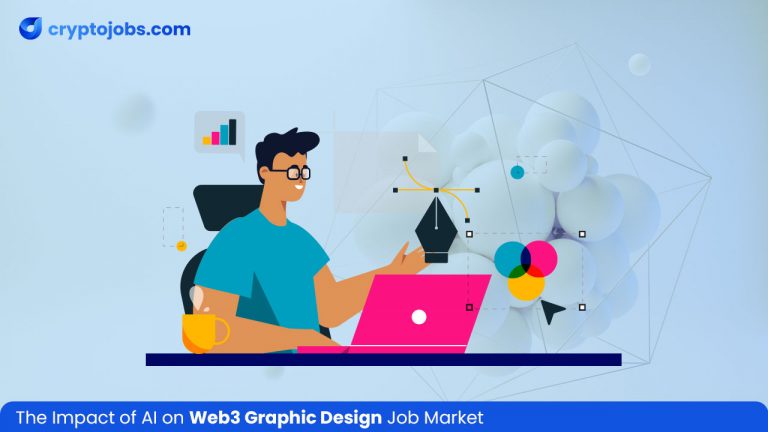
The Impact of AI on Web3 Graphic Design Job Market
- cryptojobs.com
- April 17, 2024
- All Posts, Career Guide
- Web3
- 0 Comments
The combination of creativity and technology has led to a significant shift in the graphic design industry in recent years. This development is especially noticeable in the context of the Web3 industry, where decentralized networks and blockchain technologies are emerging and changing digital landscapes. The introduction of artificial intelligence (AI) into the Web3 graphic design industry is at the core of this change, offering prospects as well as difficulties for experts in the sector.
For a very long time, graphic design has been highly regarded for its capacity to effectively convey ideas, concepts, and brands via a variety of media. However, the role of the conventional graphic designer is changing as a result of the rapid advancement of technology. A paradigm change has occurred with the introduction of AI, which holds the potential to transform processes, foster innovation, and reinvent design itself.
We explore the complex relationship between AI and the Web3 graphic design job market in this discussion. Join us as we examine the effects of AI integration on the duties and roles of graphic designers, discussing if AI is only an instrument or if it has the ability to replace creative ability. We seek to shed light on the future of graphic design in the era of artificial intelligence, as well as the implications for the larger Web3 ecosystem, by investigating important discoveries and developing trends.
AI: The Creative Powerhouse in Graphic Design
AI has immense potential in the design field thanks to its ability to harness data analysis and pattern recognition to craft aesthetically pleasing and functional designs. However, there is more to it.
Automation
AI’s impact on graphic design is poised to be transformative, particularly through automated content generation. By analyzing data and understanding design principles, AI tools like Stable Diffusion, and DALL-E 2 can swiftly create layouts and compositions, liberating designers from repetitive tasks such as image resizing or background removal. This automation streamlines workflows, empowering designers to channel their energy into more innovative endeavors.
Creativity
AI algorithms are great partners that provide designers with new insights they would not have considered before. AI offers insights and inspiration through the analysis of large design libraries, facilitating the investigation of novel ideas and pushing the frontiers of creativity. For instance, designers may use AI to create many logo design variations, which might inspire ideas and provide components, color schemes, or layout suggestions. This cooperative method encourages creativity in addition to saving time.
Image Editing
Workflows in Web3 graphic design are changing as a result of AI-driven image editing programs like Canva and MS Designer. They greatly reduce the amount of human labor required by designers by automating processes like picture enhancement and retouching. The capacity of AI to upscale low-resolution photos while preserving visual integrity is very remarkable; this is advantageous for projects requiring print media or large-scale graphics. This development guarantees excellent results even when expanding photographs and expedites the editing process. Web3 graphic designers may spend more time and energy honing creative concepts and producing outstanding visual experiences by utilizing AI skills.
Brand Imaging
AI transforms brand design by creating images, colors, and logos based on audience preferences. AI makes design recommendations that are consistent with brand identity by examining user data and industry trends. Additionally, it assesses element performance and provides guidance for continuous improvement. This data-driven approach ensures that the brand remains relevant and appeals to customers over time by promoting ongoing improvement.
Ethical Considerations and Laws
The use of AI in graphic design presents several difficulties as well as moral dilemmas. Questions around copyright, designer responsibilities, and the veracity of AI-generated art are subject to close examination. The challenge for designers is to maintain their distinctive contributions in the face of automation as AI designs spread. It becomes crucial to strike a balance between AI support and human innovation to make sure ideas respect moral principles and retain uniqueness. It takes careful thinking and adaptability to changing ethical standards in the ever-changing field of graphic design to navigate these complications.
Final Remarks
In conclusion, artificial intelligence is unquestionably the future of Web3 graphic design since it has the potential to transform workflows, encourage creativity, and provide customized designs. In order to further their creative endeavors, designers need to embrace cooperation as AI develops. The opportunities AI presents for visual design are exciting and revolutionary, even though there are still difficulties. Adopting AI should be accompanied by a commitment to preserving the uniqueness and creativity that are ingrained in every design endeavor. Accompany this exciting progress as a Web3 visual designer.
Visit cryptojobs.com today to discover fascinating graphic design employment opportunities for those seeking employment within the AI-driven Web3 landscape and traditional Web3 opportunities in design.




